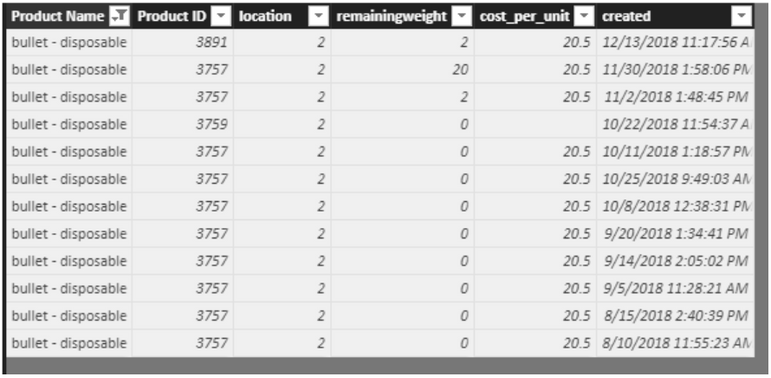- Power BI forums
- Updates
- News & Announcements
- Get Help with Power BI
- Desktop
- Service
- Report Server
- Power Query
- Mobile Apps
- Developer
- DAX Commands and Tips
- Custom Visuals Development Discussion
- Health and Life Sciences
- Power BI Spanish forums
- Translated Spanish Desktop
- Power Platform Integration - Better Together!
- Power Platform Integrations (Read-only)
- Power Platform and Dynamics 365 Integrations (Read-only)
- Training and Consulting
- Instructor Led Training
- Dashboard in a Day for Women, by Women
- Galleries
- Community Connections & How-To Videos
- COVID-19 Data Stories Gallery
- Themes Gallery
- Data Stories Gallery
- R Script Showcase
- Webinars and Video Gallery
- Quick Measures Gallery
- 2021 MSBizAppsSummit Gallery
- 2020 MSBizAppsSummit Gallery
- 2019 MSBizAppsSummit Gallery
- Events
- Ideas
- Custom Visuals Ideas
- Issues
- Issues
- Events
- Upcoming Events
- Community Blog
- Power BI Community Blog
- Custom Visuals Community Blog
- Community Support
- Community Accounts & Registration
- Using the Community
- Community Feedback
Register now to learn Fabric in free live sessions led by the best Microsoft experts. From Apr 16 to May 9, in English and Spanish.
- Power BI forums
- Forums
- Get Help with Power BI
- Desktop
- Normalize data contents of two tables into one new...
- Subscribe to RSS Feed
- Mark Topic as New
- Mark Topic as Read
- Float this Topic for Current User
- Bookmark
- Subscribe
- Printer Friendly Page
- Mark as New
- Bookmark
- Subscribe
- Mute
- Subscribe to RSS Feed
- Permalink
- Report Inappropriate Content
Normalize data contents of two tables into one new table
Hi,
Any advice on how I can Normalize these two tables into one? I am having a tough time getting this data manipulated in Power Bi Query.
I have these two data source tables. I want to Normalize them into one table. What would the best way to do this?
Would it be best to use a Calculated Table? Filter?
Ideally, I want one table that returns the most recent Product Name, Summed Remaining Inventory, Most Recent Cost Per Unit, Most Recent Retail Price.
Table 1 : Product Data
Product data Example #1
Table 2 : Inventory Data
I am running into the Product having same but different name and Id's too… For some of the Products. Not sure the best way to filter all this.
Table 1 : Product Data
Product data Example #2
Table 2 : Inventory Data
Would I sort by Latest product name and id first? Then, grab the Current Inventory, Cost of Product, and Retail Price in a Filter or Calculated table?
I added in two Calculated Columns for MAXDATE and Latest into the Products Data Table. I just can't combine the two tables effectively that returns the correct most recent updated data.
Normally, in Excel I would use Pivot tables and Vlookup, but I am excited about the automated capabilities of Power Bi!
I am new to Power Bi and at DAX too, but need some advice on the best way to create my data model with this data source.
Thanks for all the help!
Solved! Go to Solution.
- Mark as New
- Bookmark
- Subscribe
- Mute
- Subscribe to RSS Feed
- Permalink
- Report Inappropriate Content
Hi ModernAchilles,
Merge the two tables based on column created. Suppose the merged table named 'Merge', then create four measures like pattern below:
most recent Product Name =
CALCULATE (
MAX ( Merge[Product Name] ),
FILTER ( Merge, Merge[created] = MIN ( Merge[created] ) )
)
most recent Summed Remaining Inventory =
CALCULATE (
MAX ( Merge[Summed Remaining Inventory] ),
FILTER ( Merge, Merge[created] = MIN ( Merge[created] ) )
)
most recent Cost Per Unit =
CALCULATE (
MAX ( Merge[Cost Per Unit] ),
FILTER ( Merge, Merge[created] = MIN ( Merge[created] ) )
)
most recent Retail Price =
CALCULATE (
MAX ( Merge[Retail Price] ),
FILTER ( Merge, Merge[created] = MIN ( Merge[created] ) )
)
Regards,
Jimmy Tao
- Mark as New
- Bookmark
- Subscribe
- Mute
- Subscribe to RSS Feed
- Permalink
- Report Inappropriate Content
Hi ModernAchilles,
Merge the two tables based on column created. Suppose the merged table named 'Merge', then create four measures like pattern below:
most recent Product Name =
CALCULATE (
MAX ( Merge[Product Name] ),
FILTER ( Merge, Merge[created] = MIN ( Merge[created] ) )
)
most recent Summed Remaining Inventory =
CALCULATE (
MAX ( Merge[Summed Remaining Inventory] ),
FILTER ( Merge, Merge[created] = MIN ( Merge[created] ) )
)
most recent Cost Per Unit =
CALCULATE (
MAX ( Merge[Cost Per Unit] ),
FILTER ( Merge, Merge[created] = MIN ( Merge[created] ) )
)
most recent Retail Price =
CALCULATE (
MAX ( Merge[Retail Price] ),
FILTER ( Merge, Merge[created] = MIN ( Merge[created] ) )
)
Regards,
Jimmy Tao
- Mark as New
- Bookmark
- Subscribe
- Mute
- Subscribe to RSS Feed
- Permalink
- Report Inappropriate Content
Hi Jimmy,
Thanks for the help! Your advice on merging the tables really helped me solve it.
I Used the Product Name and ID with a Left Outer on the inventory table to create the new table. Where I can now pull the right information like you suggested in those formulas.
Thanks again!
Helpful resources

Microsoft Fabric Learn Together
Covering the world! 9:00-10:30 AM Sydney, 4:00-5:30 PM CET (Paris/Berlin), 7:00-8:30 PM Mexico City

Power BI Monthly Update - April 2024
Check out the April 2024 Power BI update to learn about new features.

| User | Count |
|---|---|
| 114 | |
| 97 | |
| 86 | |
| 70 | |
| 62 |
| User | Count |
|---|---|
| 151 | |
| 120 | |
| 103 | |
| 87 | |
| 68 |





